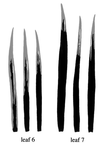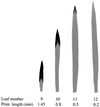Phase identity of the maize leaf is determined after leaf initiation
- PMID: 10973480
- PMCID: PMC27076
- DOI: 10.1073/pnas.180301597
Phase identity of the maize leaf is determined after leaf initiation
Abstract
The vegetative development of the maize shoot can be divided into juvenile and adult phases based on the types of leaves produced at different times in shoot development. Models for the regulation of phase change make explicit predictions about when the identity of these types of leaves is determined. To test these models, we examined the timing of leaf type determination in maize. Clones induced in transition leaf primordia demonstrated that the juvenile and adult regions of these leaves do not become clonally distinct until after the primordium is 700 microm in length, implying that these cell fates were undetermined at this stage of leaf development. Adult shoot apices were cultured in vitro to induce rejuvenation. We found that leaf primordia as large as 3 mm in length can be at least partially rejuvenated by this treatment, and the location of rejuvenated tissue is correlated with the maturation pattern of the leaf. The amount and distribution of juvenile tissue in rejuvenated leaves suggests that rejuvenation occurs nearly simultaneously in all leaf primordia. In vitro culture rejuvenated existing leaf primordia and the P0 primordium, but did not change the identity of subsequent primordia or the total number of leaves produced by the shoot. This result suggests that leaf identity can be regulated independently of the identity of the shoot apical meristem, and it implies that vegetative phase change is not initiated by a change in the identity of the shoot apical meristem.
Figures






Similar articles
-
The specification of leaf identity during shoot development.Annu Rev Cell Dev Biol. 1998;14:373-98. doi: 10.1146/annurev.cellbio.14.1.373. Annu Rev Cell Dev Biol. 1998. PMID: 9891788 Review.
-
Microarray analysis of vegetative phase change in maize.Plant J. 2008 Dec;56(6):1045-57. doi: 10.1111/j.1365-313X.2008.03661.x. Epub 2008 Sep 19. Plant J. 2008. PMID: 18764925
-
The early phase change gene in maize.Plant Cell. 2002 Jan;14(1):133-47. doi: 10.1105/tpc.010406. Plant Cell. 2002. PMID: 11826304 Free PMC article.
-
The liguleless2 gene of maize functions during the transition from the vegetative to the reproductive shoot apex.Plant J. 1999 Aug;19(4):489-95. doi: 10.1046/j.1365-313x.1999.00541.x. Plant J. 1999. PMID: 10504571
-
The integration of leaf-derived signals sets the timing of vegetative phase change in maize, a process coordinated by epigenetic remodeling.Plant Sci. 2021 Nov;312:111035. doi: 10.1016/j.plantsci.2021.111035. Epub 2021 Aug 27. Plant Sci. 2021. PMID: 34620439 Review.
Cited by
-
Heteroblastic Development of Transfer Cells Is Controlled by the microRNA miR156/SPL Module.Plant Physiol. 2017 Mar;173(3):1676-1691. doi: 10.1104/pp.16.01741. Epub 2017 Jan 12. Plant Physiol. 2017. PMID: 28082719 Free PMC article.
-
A machine learning approach for estimating forage maize yield and quality in NW Spain.PLoS One. 2025 Aug 12;20(8):e0326364. doi: 10.1371/journal.pone.0326364. eCollection 2025. PLoS One. 2025. PMID: 40794726 Free PMC article.
-
Understanding Past, and Predicting Future, Niche Transitions based on Grass Flowering Time Variation.Plant Physiol. 2020 Jul;183(3):822-839. doi: 10.1104/pp.20.00100. Epub 2020 May 13. Plant Physiol. 2020. PMID: 32404414 Free PMC article. Review.
-
Juvenile Leaves or Adult Leaves: Determinants for Vegetative Phase Change in Flowering Plants.Int J Mol Sci. 2020 Dec 21;21(24):9753. doi: 10.3390/ijms21249753. Int J Mol Sci. 2020. PMID: 33371265 Free PMC article. Review.
-
Redundant functions of miR156-targeted SQUAMOSA PROMOTER BINDING PROTEIN-LIKE transcription factors in promoting cauline leaf identity.New Phytol. 2025 Jul;247(2):719-737. doi: 10.1111/nph.70210. Epub 2025 May 12. New Phytol. 2025. PMID: 40356221 Free PMC article.
References
-
- Allsopp A. Adv Morphol. 1967;6:127–171. - PubMed
-
- Goebel K. Organography of Plants. Part I. General Organography (English translation by Balfour, I. B.) Oxford: Clarendon; 1900.
-
- Jones C S. Int J Plant Sci. 1999;160:S105–S111. - PubMed
-
- Kerstetter R A, Poethig R S. Annu Rev Cell Dev Biol. 1998;14:373–398. - PubMed
-
- Coen E S, Meyerowitz E M. Nature (London) 1991;353:31–37. - PubMed
Publication types
MeSH terms
LinkOut - more resources
Full Text Sources

